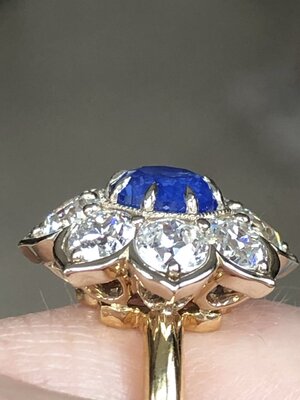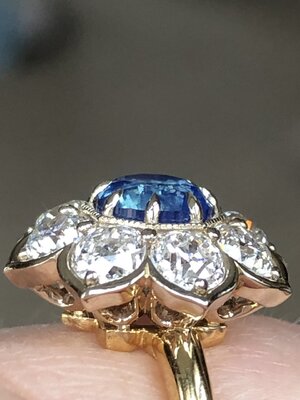I feel like this should not be a hard question to answer but I can not find it. And I know that having the corundum crystal's c-axis perpendicular to the table is not the be-all and end-all for sapphire beauty. But is there a way to post-hoc determine the "orientation" of the native crystal material in the faceted stone? I don't know a dichroscope from a polariscope, etc.
You are using an out of date browser. It may not display this or other websites correctly.
You should upgrade or use an alternative browser.
You should upgrade or use an alternative browser.
How to tell if a sapphire table is perpendicular to the c-axis?
- Thread starter LilAlex
- Start date
- Joined
- Jan 22, 2014
- Messages
- 7,031
Hopefully I’ll make sense.
sapphires are dichroic so depending on the viewing angle, the colour seen is different. With blue sapphire it’s usually green (ish) or grey purple (ish) when viewing angle is 90 degrees to the c axis.This is easiest seen with a dichroscope. It can be suble or quite distinct depending on the gem crystal.
There are a number of factors when a gem cutter is deciding to facet a gem. Which orientation provides the best end size, best colour, disguises any colour zoning and excludes any major inclusions / crystal flaws.
sapphires are dichroic so depending on the viewing angle, the colour seen is different. With blue sapphire it’s usually green (ish) or grey purple (ish) when viewing angle is 90 degrees to the c axis.This is easiest seen with a dichroscope. It can be suble or quite distinct depending on the gem crystal.
There are a number of factors when a gem cutter is deciding to facet a gem. Which orientation provides the best end size, best colour, disguises any colour zoning and excludes any major inclusions / crystal flaws.
- Joined
- Oct 19, 2013
- Messages
- 5,907
I feel like this should not be a hard question to answer but I can not find it. And I know that having the corundum crystal's c-axis perpendicular to the table is not the be-all and end-all for sapphire beauty. But is there a way to post-hoc determine the "orientation" of the native crystal material in the faceted stone? I don't know a dichroscope from a polariscope, etc.
Interesting question!
assuming color zoning might get confusing (to uneducated as I) when looking via naked eye in some cases?
This is mine, just rotated ring 180deg. Same lighting/time of day.


VividRed
Brilliant_Rock
- Joined
- Dec 25, 2018
- Messages
- 906
^ Thank you -- these are good observations!
In my case, there is no visible dichroism at 90 degrees to the table (looking in "through the sides" of the stone). So I am still left with not knowing if there is only subtle dichroism or the orientation is suboptimal.
You need a dichroscope or enough experience with cutting gems.
I have neither of the two
OK, so it is not just the dichroscope but knowing how to use it.  I see that they are all of $30 for a decent calcite one.
I see that they are all of $30 for a decent calcite one.
Richard Hughes notes (https://www.lotusgemology.com/index...96-pleochroism-in-faceted-gems-lotus-gemology):
"...When viewed in transmitted light with a dichroscope, pleochroism in uniaxial stones varies in the following ways...
Richard Hughes notes (https://www.lotusgemology.com/index...96-pleochroism-in-faceted-gems-lotus-gemology):
"...When viewed in transmitted light with a dichroscope, pleochroism in uniaxial stones varies in the following ways...
- Parallel to the c-axis, only the ordinary ray is seen and thus there is no pleochroism..."
Starstruck8
Brilliant_Rock
- Joined
- May 13, 2021
- Messages
- 869
That's the theory...
I have a calcite dichroscope. I tried this on my sapphires, looking down through the table. I couldn't see an effect like those in Hughes' figures 5 or 6 in any orientation. Maybe my sapphires are too small. Or maybe I need to tune my eyes.
Maybe my sapphires are too small. Or maybe I need to tune my eyes.
By contrast, it was easy to spot dichroism when looking sideways through the dome of a star sapphire.
I have a calcite dichroscope. I tried this on my sapphires, looking down through the table. I couldn't see an effect like those in Hughes' figures 5 or 6 in any orientation.
By contrast, it was easy to spot dichroism when looking sideways through the dome of a star sapphire.
Share:
Featured Topics
The Ultimate Guide to Men’s Wedding Bands: Metals, Fit & Finish
The Ultimate Guide to Men’s Wedding Bands: Metals, Fit & Finish - 06/27
Chipped Diamonds: Causes, Risks, and What You Should Do About It
Chipped Diamonds: Causes, Risks, and What You Should Do About It - 06/27







300x240.png)